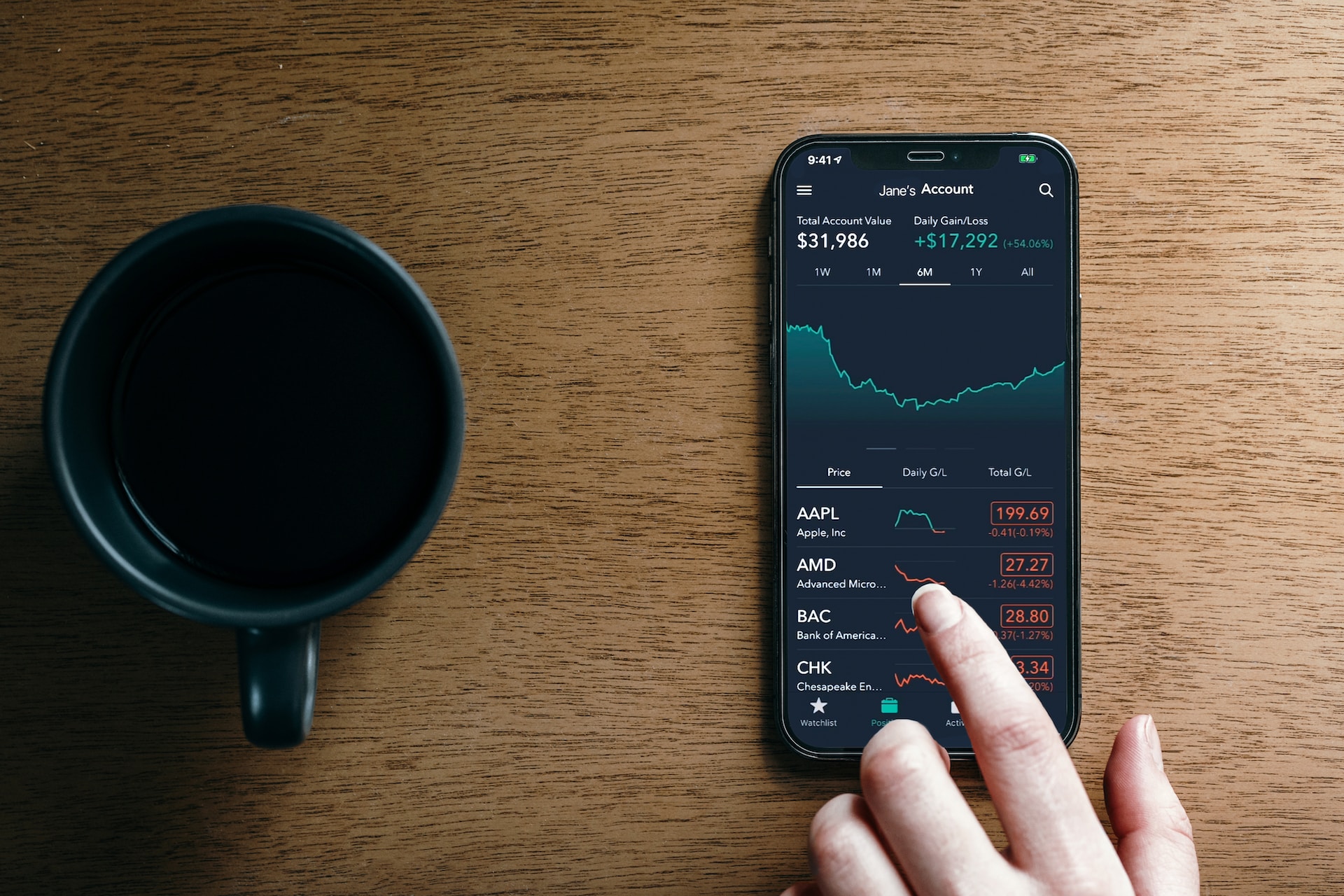Πώς να αγοράσετε ομόλογα δημοσίου;

Η βάση της επενδυτικής σας εκπαίδευσης πρέπει να είναι η κατανόηση της διαδικασίας αγοράς ομολόγων. Ένα καλά διαφοροποιημένο χαρτοφυλάκιο πρέπει πάντα να εξασφαλίζει ισορροπία μεταξύ μετοχών και ομολόγων, βοηθώντας σας να διαχειριστείτε τις διακυμάνσεις της αγοράς ενώ επωφελείστε από την ανάπτυξη.
Η Just2Trade είναι έτοιμη να σας παρέχει όλες τις απαραίτητες πληροφορίες, συμπεριλαμβανομένου του τρόπου και του τόπου αγοράς κρατικών ομολόγων το 2022, τα οφέλη που μπορείτε να αποκομίσετε, τις προκλήσεις που μπορεί να συναντήσετε και τους κινδύνους που πρέπει πάντα να λαμβάνει υπόψη κάθε επενδυτής. Ας περάσουμε στην ουσία!
Πίνακας περιεχομένων
Ομόλογα δημοσίου: Τι είναι αυτό το προϊόν;
Ποιος εκδίδει κρατικά ομόλογα;
Από τι εξαρτάται η αποδοτικότητα των κρατικών ομολόγων;
Ποια ομόλογα να επιλέξετε – Με σταθερό ή μεταβλητό επιτόκιο;
Ο κίνδυνος του πληθωρισμού
Μπορεί μια χώρα να χρεοκοπήσει;
Ομόλογα δημοσίου vs. Ομόλογα με εγγύηση του δημοσίου
Ομόλογα δημοσίου: Επιτόκια και άλλες παράμετροι
Περίοδοι εξαγοράς για κρατικά ομόλογα της Πολωνίας
Τύποι κρατικών ομολόγων που προσφέρονται από το δημόσιο
Βασικά χαρακτηριστικά και πλεονεκτήματα των αποταμιευτικών ομολόγων δημοσίου
Πού και πώς να αγοράσετε κρατικά ομόλογα της Πολωνίας
Πώς να αγοράσετε κρατικά ομόλογα στη δευτερογενή αγορά
Πού να αγοράσετε ξένα ομόλογα
Πώς να δημιουργήσετε μια «Σκάλα» ομολόγων
Πώς να αγοράσετε αμοιβαία κεφάλαια ομολόγων
Πώς να αγοράσετε ETFs ομολόγων
Συμπέρασμα
Συχνές ερωτήσεις (FAQ)
Ομόλογα δημοσίου: Τι είναι αυτό το προϊόν;
Τα κρατικά ομόλογα, όπως και τα εταιρικά ή δημοτικά ομόλογα, ανήκουν στην κατηγορία των ομολόγων. Ένα ομόλογο είναι ένα χρηματοοικονομικό εργαλείο που αντιπροσωπεύει ένα δάνειο που παρέχει ο κάτοχος του ομολόγου στον εκδότη, ο οποίος αναλαμβάνει την υποχρέωση να αποπληρώσει το δάνειο μαζί με τους τόκους σε μια προκαθορισμένη μελλοντική ημερομηνία.
Σε αντίθεση με τα φυσικά έγγραφα, τα κρατικά ομόλογα υπάρχουν σε ηλεκτρονική μορφή και καταγράφονται στο Εθνικό Αποθετήριο Κινητών Αξιών. Κατά την αγορά ενός κρατικού ομολόγου, ο αγοραστής λαμβάνει μια επιβεβαίωση της συναλλαγής. Σε περίπτωση απώλειας αυτής της επιβεβαίωσης, το ομόλογο δεν χάνεται, καθώς οι πληροφορίες της αγοράς αποθηκεύονται με ασφάλεια στο Μητρώο Αγοραστών Ομολόγων. Για να αποκτήσει κάποιος νέο αντίγραφο της επιβεβαίωσης για αυτό το είδος κινητής αξίας, μπορεί να επισκεφθεί το πλησιέστερο Σημείο Πώλησης Ομολόγων, έχοντας μαζί του την ταυτότητά του.
Ποιος εκδίδει κρατικά ομόλογα;
Τα κρατικά ομόλογα εγκρίνονται για έκδοση από τον αρμόδιο υπουργό που είναι υπεύθυνος για τα οικονομικά θέματα της χώρας, όπως ο Υπουργός Οικονομικών στην Πολωνία. Η διανομή και η πώληση αυτών των ομολόγων διευκολύνονται από έναν εξουσιοδοτημένο διαχειριστή έκδοσης. Επιπλέον, τα ομόλογα μπορούν να διατίθενται μέσω δημοπρασιών, προσελκύοντας μεγάλους επενδυτές, κυρίως τράπεζες, επενδυτικά ταμεία και ασφαλιστικές εταιρείες.
Τα έσοδα από την πώληση κρατικών ομολόγων χρησιμοποιούνται για τη χρηματοδότηση μιας ευρείας γκάμας κρατικών δαπανών. Αυτές περιλαμβάνουν τομείς όπως η εκπαίδευση, ο πολιτισμός, η δημόσια διοίκηση, η κοινωνική πρόνοια και το δικαστικό σύστημα. Επιπλέον, τα έσοδα αξιοποιούνται για την ανάπτυξη υποδομών, την υλοποίηση πρωτοβουλιών προστασίας του περιβάλλοντος και άλλα σημαντικά έργα.
Δεδομένης της τάσης των πολιτικών να υπόσχονται χωρίς πάντα να λαμβάνουν υπόψη τις οικονομικές συνέπειες, το κράτος χρειάζεται συνεχώς κεφάλαια. Ως αποτέλεσμα, η έκδοση κρατικών ομολόγων αποτελεί μια διαρκή ανάγκη.
Από τι εξαρτάται η αποδοτικότητα των κρατικών ομολόγων;
Οι αποδόσεις των κρατικών ομολόγων, ως χρεωστικοί τίτλοι που εκδίδονται από το Δημόσιο, επηρεάζονται από πληθώρα παραγόντων. Ορισμένοι από αυτούς σχετίζονται άμεσα με τα ίδια τα ομόλογα, τους οποίους θα αναλύσουμε σύντομα, ενώ άλλοι εξαρτώνται από το ευρύτερο χρηματοοικονομικό περιβάλλον, όπως τα επιτόκια, τα επίπεδα πληθωρισμού, οι ρυθμοί ανάπτυξης του Ακαθάριστου Εγχώριου Προϊόντος (ΑΕΠ) και οι ανάγκες δανεισμού της κυβέρνησης.
Κατά συνέπεια, είναι δύσκολο να προσδιοριστεί με ακρίβεια ποια κρατικά ομόλογα προσφέρουν τη μεγαλύτερη αποδοτικότητα. Γενικά, οι αποδόσεις τους συνδέονται στενά με τα επικρατούντα επιτόκια. Ωστόσο, μπορεί να προκύψει μια κατάσταση όπου η χρήση κυκλικών καταθετικών προϊόντων, όπως οι λογαριασμοί αποταμίευσης ή οι προθεσμιακές καταθέσεις, που προσαρμόζονται στις συνθήκες της αγοράς, να αποφέρει μεγαλύτερα κέρδη από την επένδυση σε μακροπρόθεσμα ομόλογα.
Ποια ομόλογα να επιλέξετε – Με σταθερό ή μεταβλητό επιτόκιο;
Η χρονική στιγμή αγοράς ομολόγων αποτελεί καθοριστικό παράγοντα που επηρεάζει την αποδοτικότητά τους. Αντί να εστιάζετε σε μια συγκεκριμένη ημέρα ή μήνα, η απόφαση βασίζεται στο στάδιο του οικονομικού κύκλου.
Κατά τη διάρκεια περιόδων οικονομικής επιβράδυνσης ή ενδείξεων για μείωση των επιτοκίων, συνιστάται να εξετάσετε την επένδυση σε ομόλογα με σταθερό επιτόκιο.
Αντίθετα, όταν η οικονομία βρίσκεται σε φάση ευημερίας και υπάρχει πιθανότητα αύξησης των επιτοκίων, είναι φρόνιμο να εξετάσετε την επένδυση σε ομόλογα με μεταβλητό επιτόκιο.
Αυτό συμβαίνει επειδή ο αγοραστής του ομολόγου απολαμβάνει τους όρους που καθορίζονται στη συμφωνία έκδοσης μέχρι την ημερομηνία εξαγοράς. Για παράδειγμα, αν αγοράσετε ομόλογα με σταθερό επιτόκιο 3% και τα επιτόκια στη συνέχεια μειωθούν, ακόμη και αν οι τράπεζες προσφέρουν καταθέσεις με επιτόκιο 2% ή ακόμα και 1%, θα συνεχίσετε να λαμβάνετε την συμφωνημένη απόδοση του 3%.
Αντίθετα, αν αποκτούσατε τα ίδια ομόλογα κατά τη διάρκεια οικονομικής άνθησης, όταν το Συμβούλιο Νομισματικής Πολιτικής αυξάνει τα επιτόκια και τα επιτόκια καταθέσεων εκτοξεύονται, θα εξακολουθούσατε να κερδίζετε την προκαθορισμένη απόδοση του 3%.
Ο κίνδυνος του πληθωρισμού
Πού μπορείτε να αγοράσετε κρατικά ομόλογα συνδεδεμένα με τον πληθωρισμό; Ας εξετάσουμε αυτήν την περίπτωση πιο αναλυτικά.
Δυστυχώς, η ζωή δεν είναι απλή. Όχι μόνο είναι δύσκολο να προβλεφθούν οι οικονομικές εξελίξεις, αλλά πρέπει επίσης να αντιμετωπίζουμε τις διακυμάνσεις των επιτοκίων σε μεσοπρόθεσμα και μακροπρόθεσμα ομόλογα. Αρχικά, ο τόκος στις αποταμιεύσεις μπορεί να υπολογιστεί με ακρίβεια, βασισμένος στην καθορισμένη τιμή της συμφωνίας έκδοσης. Ωστόσο, στα επόμενα χρόνια, η απόδοση γίνεται ένας άγνωστος παράγοντας, ο οποίος εξαρτάται, εν μέρει, από τον πληθωρισμό.
Παρόλα αυτά, μπορεί να υπάρξει ο πειρασμός να υπολογίσετε το επίπεδο απόδοσης, οδηγώντας σε ένα σενάριο όπου ούτε κερδίζετε ούτε χάνετε αξία. Μπορεί να φαίνεται απίστευτο, αλλά αυτή η πιθανότητα υπάρχει, λαμβάνοντας υπόψη τον φόρο κεφαλαιακών κερδών ύψους 19%, γνωστό και ως "φόρος Belka".
Το όριο για τον πληθωρισμό, πέρα από το οποίο "καταναλώνει" τα κέρδη σας, προσδιορίζεται από τον εξής τύπο:
πληθωρισμός = (81% : 19%) x περιθώριο
Για παράδειγμα, με περιθώριο ορισμένο στο 1%, το όριο πληθωρισμού διαμορφώνεται στο 4,26%, ενώ με περιθώριο 1,5% αυξάνεται στο 6,40%. Δυστυχώς, αν η αύξηση των τιμών υπερβεί αυτά τα όρια, οι αποδόσεις σας θα μειωθούν.
Είναι σημαντικό να σημειωθεί ότι αυτές οι εκτιμήσεις είναι καθαρά θεωρητικές, καθώς ο φόρος Belka επιβάλλεται μόνο κατά την εξαγορά των ομολόγων. Επομένως, ο πληθωρισμός θα πρέπει να παραμείνει πάνω από το υπολογισμένο όριο για παρατεταμένη περίοδο, ώστε τα χρήματά σας να χάσουν πραγματικά αξία.
Με αυτό, καλύψαμε το ζήτημα του πώς να αγοράσετε κρατικά ομόλογα συνδεδεμένα με τον πληθωρισμό. Συνοψίζοντας, ενώ τα κρατικά ομόλογα συνδεδεμένα με τον πληθωρισμό φέρουν έναν βαθμό αβεβαιότητας, είναι απίθανο να οδηγήσουν σε απώλειες.
Μπορεί μια χώρα να χρεοκοπήσει;
Η επένδυση αποταμιεύσεων σε κρατικά ομόλογα φέρει τη χαμηλότερη κατηγορία κινδύνου, κυρίως λόγω της πλήρους ευθύνης του κράτους για την εξαγορά τους. Στην Πολωνία, αυτή η διασφάλιση αναφέρεται ρητά στο Άρθρο 95(6) του Νόμου για τα Δημόσια Οικονομικά.
Επιπλέον, το Άρθρο 165, σημείο 1 του ίδιου νόμου παρέχει μια πρόσθετη εγγύηση, δίνοντας προτεραιότητα στην εξυπηρέτηση του δημόσιου χρέους έναντι άλλων δαπανών του κρατικού προϋπολογισμού. Ουσιαστικά, οι υποχρεώσεις που προκύπτουν από εκδοθέντα κρατικά χρεόγραφα έχουν την υψηλότερη προτεραιότητα και πρέπει να εκπληρώνονται πρώτες.
Ωστόσο, είναι σημαντικό να ληφθεί υπόψη η πιθανότητα αλλαγής του πολιτικού συστήματος, όπου μια νέα κυβέρνηση μπορεί να δηλώσει σαφή αποστασιοποίηση από το παρελθόν, ακόμη και σε οικονομικούς όρους. Ένα τέτοιο σενάριο θα μπορούσε να οδηγήσει σε απώλεια εμπιστοσύνης τόσο στο κράτος όσο και στη χρηματοπιστωτική αγορά, προκαλώντας σημαντικό πληθωρισμό και σοβαρές δημοσιονομικές προκλήσεις για πολλά νοικοκυριά.
Ζήσαμε μια παρόμοια κατάσταση μετά τον Β' Παγκόσμιο Πόλεμο, όταν οι κομμουνιστικές αρχές αποφάσισαν να μην αναγνωρίσουν τα ομόλογα που είχαν εκδοθεί από τη Δεύτερη Δημοκρατία, προκαλώντας σοβαρές επιπτώσεις.
)
Ομόλογα δημοσίου vs. Ομόλογα με εγγύηση του δημοσίου
Τα ομόλογα που εκδίδονται από άλλους φορείς μπορεί να έχουν το δημόσιο είτε ως εκδότη είτε ως εγγυητή. Ας εξετάσουμε τις επιπτώσεις αυτού.
Ομόλογα δημοσίου
Ο όρος «ομόλογα δημοσίου» αναφέρεται συγκεκριμένα σε πολωνικούς χρεωστικούς τίτλους και υπογραμμίζει το Δημόσιο Ταμείο ως εκδότη, εκπροσωπούμενο από τον υπουργό Οικονομικών, ο οποίος είναι υπεύθυνος απέναντι στο Υπουργείο Οικονομικών. Με την επένδυση σε ομόλογα δημοσίου, οι πολίτες δανείζουν χρήματα στο κράτος, το οποίο δεσμεύεται να επιστρέψει το δάνειο με τόκους, βάσει των όρων που περιγράφονται στο έγγραφο έκδοσης της συγκεκριμένης σειράς.
Τα ομόλογα δημοσίου εκδίδονται σε μηνιαία βάση και σε προκαθορισμένη τιμή. Αγοράζονται κυρίως από επενδυτικά ταμεία, τράπεζες και άλλους χρηματοοικονομικούς οργανισμούς, καθώς θεωρούνται η πιο ασφαλής μορφή επένδυσης κεφαλαίου. Αυτά τα ομόλογα μπορούν να διαπραγματεύονται στην αγορά Catalyst του Χρηματιστηρίου.
Μια πιο περιορισμένη κατηγορία ομολόγων, γνωστή ως αποταμιευτικά (λιανικής) ομόλογα, είναι διαθέσιμη αποκλειστικά σε επενδυτές λιανικής, όπως φυσικά πρόσωπα (κάτοικοι και μη κάτοικοι), ενώσεις, κοινωνικές και επαγγελματικές οργανώσεις, καθώς και ιδρύματα εγγεγραμμένα σε δικαστήριο.
Αυτοί οι χρεωστικοί τίτλοι πωλούνται επίσης σε σταθερή τιμή και παρέχουν τη δυνατότητα πρόωρης εξαγοράς. Ωστόσο, δεν είναι εισηγμένοι στο Χρηματιστήριο της Βαρσοβίας (WSE).
Ομόλογα με εγγύηση του δημοσίου
Όταν εξετάζετε πώς να αγοράσετε κρατικά ομόλογα, είναι σημαντικό να σημειωθεί ότι, εκτός από το Δημόσιο που εκδίδει τέτοια ομόλογα, λειτουργεί επίσης ως εγγυητής για ομόλογα που εκδίδονται από άλλους φορείς, όπως η τράπεζα ανάπτυξης της Πολωνίας (Bank Gospodarstwa Krajowego - BGK) ή το ταμείο ανάπτυξης της Πολωνίας (Polish Development Fund - PFR).
Αυτοί οι οργανισμοί εκδίδουν ομόλογα στην αγορά με παρόμοιο στόχο, δηλαδή τη συγκέντρωση κεφαλαίων για την υποστήριξη της κοινωνικής και οικονομικής ανάπτυξης της Πολωνίας. Ουσιαστικά, αυτές οι ενέργειες πραγματοποιούνται εκ μέρους του κράτους από εξειδικευμένους φορείς, και, ως εκ τούτου, το δημόσιο παρέχει την εγγύηση για την εξαγορά τους.
Τα ομόλογα που εκδίδονται από τη BGK και το PFR είναι εισηγμένα στο Χρηματιστήριο και διαθέτουν σταθερό επιτόκιο. Οι τόκοι καταβάλλονται ετησίως και κατατίθενται στον χρηματιστηριακό λογαριασμό του κατόχου.
Ομόλογα δημοσίου: Επιτόκια και αλλες παράμετροι
Τα κρατικά ομόλογα διαθέτουν διάφορα χαρακτηριστικά πέρα από το επιτόκιο. Οι επενδυτές μπορούν να βρουν λεπτομερείς πληροφορίες στο έγγραφο έκδοσης για κάθε σειρά ομολόγων, το οποίο περιλαμβάνει την περίοδο πώλησης, την ποσότητα των προσφερόμενων ομολόγων, τους κανόνες για το επιτόκιο και την ημερομηνία λήξης.
Ακολουθούν βασικοί όροι που πρέπει να γνωρίζετε:
- Τιμή έκδοσης: Η τιμή πώλησης την πρώτη ημέρα της έκδοσης. Εξαίρεση αποτελούν τα αποταμιευτικά ομόλογα που προσφέρονται σε σταθερή τιμή 100 PLN.
- Ονομαστική τιμή: Η αξία του ομολόγου που θα εξοφληθεί κατά την εξαγορά, μαζί με τους δεδουλευμένους τόκους.
- Τιμή πώλησης: Η τιμή που πληρώνει ο αγοραστής για τα ομόλογα την ημέρα της αγοράς.
- Τιμή μετατροπής: Η τιμή των νέων ομολόγων για όσους ανταλλάσσουν παλαιά ομόλογα κατά την εξαγορά.
- Έκπτωση: Η διαφορά μεταξύ της ονομαστικής αξίας και της τιμής έκδοσης, η οποία μπορεί να είναι χαμηλότερη από την ονομαστική αξία για συγκεκριμένες ομάδες, όπως όσοι εξαγοράζουν ομόλογα.
- Επιστολή έκδοσης: Έγγραφο στο οποίο ο εκδότης καθορίζει το επιτόκιο, τους κανόνες εξαγοράς και την ημερομηνία λήξης του ομολόγου.
- Ομόλογα με κουπόνι: Οι κάτοχοι λαμβάνουν περιοδικές πληρωμές τόκων (π.χ., κάθε έξι μήνες), ενώ το κεφάλαιο εξοφλείται κατά την εξαγορά.
- Ομόλογα χωρίς κουπόνι: Χρεωστικοί τίτλοι που προσφέρονται με έκπτωση στην ονομαστική τιμή, όπου η διαφορά αντιπροσωπεύει το κέρδος του επενδυτή.
- Αποδοτικότητα: Ο ρυθμός απόδοσης της επένδυσης σε ομόλογα, ο οποίος επηρεάζεται από παράγοντες όπως η τιμή αγοράς, το επιτόκιο, η συχνότητα πληρωμής τόκων και η μέθοδος κεφαλαιοποίησης.
- Λήξη: Η ημερομηνία κατά την οποία οι κάτοχοι των ομολόγων λαμβάνουν το κεφάλαιο που δανείστηκε, μαζί με τους δεδουλευμένους τόκους.
Περίοδοι εξαγοράς για κρατικά ομόλογα της Πολωνίας
Τα ομόλογα δημοσίου προσφέρουν επενδυτικές επιλογές για διάφορα χρονικά διαστήματα, καλύπτοντας διαφορετικές ανάγκες.
Βραχυπρόθεσμα κρατικά ομόλογα Πολωνίας
Ιδανικά για βραχυπρόθεσμες αποταμιεύσεις διάρκειας από μερικούς μήνες έως ένα έτος. Αυτά τα έντοκα γραμμάτια προσφέρουν σταθερό επιτόκιο, εξασφαλίζοντας προβλέψιμες αποδόσεις.
Μεσοπρόθεσμα κρατικά ομόλογα
Κατάλληλα για επενδυτές με χρονικό ορίζοντα από ένα έως πέντε έτη. Παρέχουν ευελιξία στη δομή των επιτοκίων, είτε μέσω σταθερών επιτοκίων με ετήσια κεφαλαιοποίηση για αυξημένα κέρδη, είτε μέσω μεταβλητών επιτοκίων που προσαρμόζονται περιοδικά βάσει παραγόντων της αγοράς.
Μακροπρόθεσμα κρατικά ομόλογα
Απευθύνονται σε μακροπρόθεσμους επενδυτές. Τα επιτόκια αυτών των ομολόγων είναι γνωστά μόνο για τον πρώτο χρόνο και στη συνέχεια συνδέονται με τον πληθωρισμό. Οι τόκοι συσσωρεύονται ετησίως, συμβάλλοντας στη σταδιακή αύξηση του επενδυτικού κεφαλαίου.
Διαρκή ομόλογα
Αυτά τα ομόλογα, συμπεριλαμβανομένων σπάνιων επιλογών διάρκειας 100 ετών, προσφέρουν συνεχή πληρωμή τόκων χωρίς εξαγορά. Οι κάτοχοί τους λαμβάνουν μια διαρκή πρόσοδο, εξασφαλίζοντας σταθερή ταμειακή ροή.
Τύποι κρατικών ομολόγων που προσφέρονται από το δημόσιο
Για την κατηγοριοποίηση και την αναγνώριση των ομολόγων, έχει καθιερωθεί ένα σύστημα συμβόλων. Κάθε ομόλογο λαμβάνει ένα σύμβολο, όπως OTS0621 ή COI0325, που αντιπροσωπεύει τον τύπο του καθώς και τον μήνα και το έτος εξαγοράς του.
Τα πολωνικά κρατικά ομόλογα είναι συνεχώς διαθέσιμα για αγορά, με νέες εκδόσεις να κυκλοφορούν κάθε μήνα. Προσφέρονται σε σταθερή τιμή 100 PLN ανά ομόλογο.
Τρίμηνα Αποταμιευτικά Ομόλογα Δημοσίου με Σταθερό Επιτόκιο OTS0823
Τιμή Πώλησης: 100,00 PLN
Σταθερό Επιτόκιο: 3,00% ετησίως
Αξία Εξαργύρωσης μετά από 3 μήνες: 100,76 PLN προ φόρων
Διαθέσιμη Επιλογή Μετατροπής: 100,00 PLN
Ετήσια Αποταμιευτικά Ομόλογα Δημοσίου με Μεταβλητό Επιτόκιο ROR0524
Τιμή Πώλησης: 100,00 PLN
Σταθερό Επιτόκιο για την Πρώτη Περίοδο: 6,75% ετησίως
Μηνιαία Πληρωμή Τόκων
Διαθέσιμη Επιλογή Μετατροπής: 99,80 PLN
Διετή Αποταμιευτικά Ομόλογα Δημοσίου με Κυμαινόμενο Επιτόκιο DOR0525
Τιμή Πώλησης: 100,00 PLN
Σταθερό Επιτόκιο για την Πρώτη Περίοδο: 6,85% ετησίως
Μηνιαία Πληρωμή Τόκων με Περιθώριο 0,10%
Διαθέσιμη Επιλογή Μετατροπής: 99,70 PLN
Τριετή Αποταμιευτικά Ομόλογα Δημοσίου με Σταθερό Επιτόκιο TOS0526
Τιμή Πώλησης: 100,00 PLN
Σταθερό Επιτόκιο: 6,85% ετησίως
Τόκοι μετά από τρία χρόνια: 21,99 PLN προ φόρων
Διαθέσιμη Επιλογή Μετατροπής: 99,60 PLN
Τετραετή Αποταμιευτικά Κρατικά Ομόλογα COI0527
Τιμή Πώλησης: 100,00 PLN
Επιτόκιο για την Πρώτη Περίοδο: 7,00% ετησίως
Επόμενα Επιτόκια: Βασισμένα στην αύξηση των τιμών καταναλωτή + περιθώριο 1,00%
Πληρωμή Τόκων: Ετησίως
Διαθέσιμη Επιλογή Μετατροπής: 99,50 PLN
Δεκαετή Αποταμιευτικά Κρατικά Ομόλογα Συνταξιοδότησης EDO0533
Τιμή Πώλησης: 100,00 PLN
Επιτόκιο για την Πρώτη Περίοδο: 7,25% ετησίως
Επόμενα Επιτόκια: Βασισμένα στην αύξηση των τιμών καταναλωτή + περιθώριο 1,25%
Πληρωμή Τόκων: Κατά την ολοκλήρωση της αποταμίευσης
Διαθέσιμη Επιλογή Μετατροπής: 99,40 PLN
Οικογενειακά Αποταμιευτικά Ομόλογα Αφιερωμένα στους Δικαιούχους του Προγράμματος "Οικογένεια 500 Plus"
Οικογενειακά Εξαετή Αποταμιευτικά Ομόλογα (ROS)
Οικογενειακά Δωδεκαετή Αποταμιευτικά Ομόλογα (ROD)
Ομόλογα με Προνομιακά Επιτόκια για τους Δικαιούχους του Προγράμματος
Οικογενειακά Εξαετή Αποταμιευτικά Ομόλογα Δημοσίου ROS0529
Τιμή Πώλησης: 100,00 PLN
Αρχικό Επιτόκιο: 7,20% ετησίως για τον πρώτο χρόνο
Επόμενο Επιτόκιο: Βασισμένο στον δείκτη τιμών καταναλωτή + περιθώριο 1,50%
Πληρωμή Τόκων: Κατά την ολοκλήρωση της αποταμίευσης
Οικογενειακά Δωδεκαετή Αποταμιευτικά Ομόλογα Δημοσίου ROD0535
Τιμή Πώλησης: 100,00 PLN
Αρχικό Επιτόκιο: 7,5% ετησίως για τον πρώτο χρόνο
Επόμενο Επιτόκιο: Βασισμένο στον δείκτη τιμών καταναλωτή + περιθώριο 1,75%
Πληρωμή Τόκων: Κατά την ολοκλήρωση της αποταμίευσης
Βασικά χαρακτηριστικά και πλεονεκτήματα των αποταμιευτικών ομολόγων δημοσίου
Τα αποταμιευτικά ομόλογα δημοσίου διαθέτουν μια σειρά από ξεχωριστά χαρακτηριστικά και πλεονεκτήματα που τα καθιστούν ελκυστική επενδυτική επιλογή. Ακολουθούν ορισμένα από τα βασικά χαρακτηριστικά τους:
Ποικιλία τύπων ομολόγων: Τα αποταμιευτικά ομόλογα δημοσίου προσφέρονται σε μια ποικιλία τύπων και περιόδων λήξης, από βραχυπρόθεσμες επιλογές (3 μήνες) έως μακροπρόθεσμες (10 χρόνια). Αυτό επιτρέπει στους επενδυτές να επιλέξουν ομόλογα που ταιριάζουν με τους επενδυτικούς τους στόχους και τον χρονικό τους ορίζοντα.
Σταθερά και μεταβλητά επιτόκια: Τα αποταμιευτικά ομόλογα δημοσίου διατίθενται με σταθερά και μεταβλητά επιτόκια, ανάλογα με τον τύπο του ομολόγου. Τα ομόλογα με σταθερά επιτόκια προσφέρουν συνέπεια και σταθερή ροή εισοδήματος, ενώ εκείνα με μεταβλητά επιτόκια έχουν τη δυνατότητα για μεγαλύτερες αποδόσεις, ανάλογα με τις συνθήκες της αγοράς.
Προστασία από τον πληθωρισμό: Ορισμένα αποταμιευτικά ομόλογα δημοσίου συνδέονται με τον πληθωρισμό, εξασφαλίζοντας ότι οι τόκοι που συλλέγονται συμβαδίζουν με την αύξηση των τιμών. Αυτά τα ομόλογα βοηθούν στην προστασία της αγοραστικής δύναμης της επένδυσής σας, λειτουργώντας ως ασπίδα ενάντια στον πληθωρισμό.
Τακτικές πληρωμές τόκων: Οι κάτοχοι ορισμένων αποταμιευτικών ομολόγων δημοσίου λαμβάνουν τακτικές πληρωμές τόκων. Αυτές οι πληρωμές, είτε μηνιαίες, ετήσιες ή κατά τη λήξη, παρέχουν στους επενδυτές μια σταθερή πηγή εισοδήματος.
Δυνατότητες μετατροπής: Τα αποταμιευτικά ομόλογα δημοσίου προσφέρουν ευελιξία μετατροπής. Οι επενδυτές έχουν τη δυνατότητα να αποκτήσουν ομόλογα από νέες εκδόσεις, χρησιμοποιώντας κεφάλαια από εξαγορασμένα ομόλογα ή μέρος αυτών. Αυτή η δυνατότητα επιτρέπει την προσαρμογή και διαφοροποίηση του χαρτοφυλακίου τους.
Χαμηλός κίνδυνος και εγγυημένη εξαγορά: Τα αποταμιευτικά ομόλογα δημοσίου θεωρούνται επενδύσεις χαμηλού κινδύνου, καθώς υποστηρίζονται από την πλήρη εμπιστοσύνη και πίστη του κράτους. Επιπλέον, η εξαγορά τους είναι εγγυημένη, προσφέροντας στους επενδυτές τη βεβαιότητα ότι η αρχική επένδυσή τους θα επιστραφεί, αφού η κυβέρνηση εγγυάται την εξόφληση των ομολόγων.
Πρόσβαση μέσω διαφόρων καναλιών πώλησης: Τα αποταμιευτικά ομόλογα δημοσίου είναι εύκολο να αγοραστούν μέσω ποικίλων καναλιών, όπως τραπεζικά καταστήματα, χρηματιστηριακές εταιρείες, διαδικτυακές πλατφόρμες και τηλεφωνικές υπηρεσίες. Αυτή η ευρεία προσβασιμότητα διευκολύνει τη συμμετοχή των επενδυτών στις προσφορές ομολόγων.
Κατάλληλα για επενδυτές λιανικής: Τα αποταμιευτικά ομόλογα δημοσίου προσφέρονται σε επενδυτές λιανικής, όπως φυσικά πρόσωπα, ενώσεις, κοινωνικές και επαγγελματικές ομάδες, καθώς και εγγεγραμμένα ιδρύματα. Η προσβασιμότητά τους επιτρέπει σε ένα ευρύ φάσμα επενδυτών να συμμετάσχουν και να επωφεληθούν από αυτά τα ομόλογα.

Πού και πώς να αγοράσετε κρατικά ομόλογα της Πολωνίας
Ομόλογα δημοσίου: Πού να τα αγοράσετε; Έχετε διάφορες βολικές επιλογές:
Διαδικτυακές πλατφόρμες:
Επισκεφθείτε το obligacjeskarbowe.pl ή αποκτήστε άμεση πρόσβαση στις ακόλουθες ιστοσελίδες: www.zakup.obligacjeskarbowe.pl, www.pkobp.obligacjeskarbowe.pl, www.pekao.com.pl/obligacje-skarbowe. Αυτές οι πλατφόρμες παρέχουν ένα φιλικό προς τον χρήστη περιβάλλον για την αγορά ομολόγων δημοσίου.
Επιπλέον, μπορείτε να πραγματοποιήσετε αγορές ομολόγων μέσω της κινητής εφαρμογής PeoPay.
Τηλεφωνικές υπηρεσίες:
Επικοινωνήστε με την PKO Bank Polski στο 0 801 310 210 ή στο (81) 535 66 55 για βοήθεια με την αγορά ομολόγων δημοσίου.
Για την Bank Polska Kasa Opieki S.A. (PKO BP), καλέστε στο (22) 591 22 00 για να εξερευνήσετε επιλογές αγοράς ομολόγων.
Σημεία πώλησης ομολόγων:
Επισκεφθείτε τα σημεία πώλησης ομολόγων που βρίσκονται εντός των καταστημάτων της PKO Bank Polski ή του Χρηματιστηριακού Γραφείου της PKO BP για αγορές ομολόγων με φυσική παρουσία.
Καταστήματα πώλησης ομολόγων:
Εξερευνήστε τα καταστήματα πώλησης ομολόγων που βρίσκονται στα υποκαταστήματα της Bank Pekao S.A. ή στο Biuro Maklerskie Pekao S.A. για την ευκαιρία να αγοράσετε ομόλογα δημοσίου.
Μπορείτε να χρησιμοποιήσετε τις μηχανές αναζήτησης των αντίστοιχων σημείων πώλησης ομολόγων μέσω των παρακάτω συνδέσμων για να βρείτε την πλησιέστερη τοποθεσία, διευκολύνοντας τη διαδικασία αγοράς σας.
Πώς να αγοράσετε κρατικά ομόλογα στη δευτερογενή αγορά
Τα κρατικά ομόλογα μπορούν να αγοραστούν στην κύρια αγορά, όπως αναφέρθηκε προηγουμένως, ή στη δευτερογενή αγορά.
Απόκτηση ομολόγων στη δευτερογενή αγορά
Η απόκτηση ομολόγων στη δευτερογενή αγορά περιλαμβάνει την εξής διαδικασία:
Σύμβαση αγοράς και πώλησης:
Για να ξεκινήσει η συναλλαγή, τόσο ο αγοραστής όσο και ο τρέχων κάτοχος των ομολόγων πρέπει να καταρτίσουν μια σύμβαση αγοράς και πώλησης. Η σύμβαση μπορεί να συνταχθεί σε τυπική συμβατική μορφή.
Επίσκεψη στο κατάστημα πώλησης ομολόγων (PSO):
Μετά την υπογραφή της σύμβασης, και τα δύο μέρη πρέπει να επισκεφθούν το κατάστημα πώλησης ομολόγων (PSO). Εκεί, μπορούν να ζητήσουν τις απαραίτητες αλλαγές που πρέπει να γίνουν στο Μητρώο Αγοραστών Ομολόγων.
Επιβεβαίωση αγοράς ομολόγων:
Μετά την ολοκλήρωση των απαιτούμενων αλλαγών, ένας υπάλληλος του καταστήματος πώλησης ομολόγων θα εκδώσει επιβεβαίωση αγοράς ομολόγων στον νέο κάτοχο
Εάν η σύμβαση αγοράς συνταχθεί με τη μορφή συμβολαιογραφικής πράξης ή τουλάχιστον επικυρωθεί συμβολαιογραφικά, ο αγοραστής των ομολόγων μπορεί να ολοκληρώσει τη διαδικασία ανεξάρτητα, επισκεπτόμενος το κατάστημα.Είναι σημαντικό να σημειωθεί ότι δεν επιβάλλεται τέλος χαρτοσήμου κατά τη σύναψη αυτού του τύπου σύμβασης.
Λάβετε υπόψη ότι οι αλλαγές μπορούν να γίνουν μόνο σε καταστήματα που λειτουργούν υπό την επωνυμία PKO BP. Στα καταστήματα της Pekao SA, η δυνατότητα πραγματοποίησης τέτοιων αλλαγών θα είναι διαθέσιμη μόλις ξεκινήσει η εξυπηρέτηση ομολόγων στα σταθερά καταστήματα, κάτι που αναμένεται κατά το πρώτο τρίμηνο του 2023.
Απόκτηση ομολόγων για ανήλικο
Η απόκτηση ομολόγων για έναν ανήλικο περιλαμβάνει τις ακόλουθες παραμέτρους:
Αγορά και εξαγορά: Ο νόμιμος εκπρόσωπος του ανηλίκου, όπως ένας γονέας ή κηδεμόνας που έχει διοριστεί από το οικογενειακό δικαστήριο, μπορεί να αγοράσει ομόλογα από τα δικά του περιουσιακά στοιχεία χωρίς περιορισμούς, προς όφελος του παιδιού υπό την επιμέλειά του. Το ίδιο ισχύει για την εξαγορά των ομολόγων καθώς και για την είσπραξη των τόκων.
Περιορισμοί και έγκριση δικαστηρίου: Ωστόσο, ισχύουν ορισμένοι περιορισμοί εάν τα ομόλογα πρόκειται να αγοραστούν από την περιουσία του ανηλίκου, να παρουσιαστούν για πρόωρη εξαγορά ή να πωληθούν σε τρίτο πριν από τη λήξη τους. Αυτές οι ενέργειες υπερβαίνουν το πλαίσιο της συνήθους διαχείρισης και απαιτούν έγκριση από το οικογενειακό δικαστήριο για την υλοποίησή τους.
Δικαιώματα εφήβων: Αξίζει να σημειωθεί ότι οι έφηβοι ηλικίας τουλάχιστον 13 ετών έχουν το δικαίωμα να αγοράσουν ομόλογα με τη συγκατάθεση ενός γονέα ή νόμιμου κηδεμόνα. Αυτή η συγκατάθεση μπορεί να παρασχεθεί είτε μέσω ξεχωριστού εγγράφου είτε ως μέρος μιας κατατεθειμένης εντολής. Για την ταυτοποίηση του ανηλίκου, οποιοδήποτε έγκυρο έγγραφο, όπως ταυτότητα, διαβατήριο ή μαθητική ταυτότητα, θεωρείται επαρκές.
Παρακαλείστε να συμβουλευτείτε νομικούς επαγγελματίες ή οικονομικούς συμβούλους για συγκεκριμένη καθοδήγηση σχετικά με την αγορά ομολόγων για ανηλίκους, καθώς οι νομικές απαιτήσεις ενδέχεται να διαφέρουν.
Πρόωρη εξαγορά κρατικών ομολόγων
Η πρόωρη εξαγορά κρατικών ομολόγων μπορεί να ζητηθεί υπό συγκεκριμένες προϋποθέσεις. Ακολουθούν ορισμένα βασικά σημεία που πρέπει να λάβετε υπόψη:
Χρονική στιγμή:
Η υποβολή αιτήματος για πρόωρη εξαγορά μπορεί να γίνει όχι νωρίτερα από 7 ημέρες μετά την απόκτηση του ομολόγου. Η προθεσμία για την υποβολή τέτοιου αιτήματος διαφέρει ανάλογα με τον τύπο του ομολόγου, κυμαινόμενη συνήθως από μερικές ημέρες έως έναν μήνα πριν από την ημερομηνία λήξης.
Κόστος και τόκοι:
Για τα 3μηνα ομόλογα (OTS), η πρόωρη εξαγορά δεν συνεπάγεται κόστος, αλλά δεν θα λάβετε τόκους για την περίοδο κατοχής του ομολόγου.Για άλλους τύπους ομολόγων, μπορεί να ισχύει τέλος εξαγοράς ύψους 0,70 PLN ανά ομόλογο. Ωστόσο, για ορισμένα ομόλογα, το τέλος αυτό χρεώνεται μόνο εάν οι δεδουλευμένοι τόκοι υπερβαίνουν το ποσό του τέλους εξαγοράς.
Διαφορετική δομή τελών:
Η δομή των τελών διαφέρει ανάλογα με τη διάρκεια του ομολόγου. Για τα 2ετή (DOS) και 4ετή (COI) ομόλογα, το τέλος ισχύει μόνο κατά την πρώτη περίοδο τόκων. Στις επόμενες περιόδους, χρεώνεται το πλήρες τέλος, γεγονός που μπορεί να οδηγήσει σε επιστροφή ποσού χαμηλότερου από την αρχική τιμή αγοράς του ομολόγου.
Υψηλότερο τέλος για μακροπρόθεσμα ομόλογα:
Τα 10ετή (EDO) και 12ετή (ROD) ομόλογα έχουν υψηλότερο τέλος, ύψους 2 PLN ανά ομόλογο. Το τέλος εφαρμόζεται σύμφωνα με τους ίδιους κανόνες που ισχύουν για τα 3ετή και 6ετή ομόλογα.
Χρόνος επεξεργασίας και δεδουλευμένοι τόκοι:
Η ανάληψη των κεφαλαίων πραγματοποιείται μετά από 5 εργάσιμες ημέρες από την ημερομηνία της εντολής εξαγοράς. Κατά τη διάρκεια αυτής της περιόδου, οι τόκοι συνεχίζουν να συσσωρεύονται, με εξαίρεση τα 3μηνα ομόλογα (OTS).
Πού να αγοράσετε ξένα ομόλογα
Τα ομόλογα μπορούν να αποκτηθούν με διάφορους τρόπους, προσφέροντας πολλές επιλογές για να ικανοποιήσουν τις ανάγκες όλων των τύπων επενδυτών. Ενώ ορισμένοι επενδυτές προτιμούν να αγοράζουν μεμονωμένα ομόλογα, άλλοι επιλέγουν ETFs ομολόγων.
Μεμονωμένα ομόλογα
Ένας επενδυτής μπορεί να αγοράσει συγκεκριμένα ομόλογα είτε στις πρωτογενείς αγορές, όπου η αγορά γίνεται απευθείας από τον εκδότη, είτε στις δευτερογενείς αγορές, όπου η αγορά γίνεται από τον προηγούμενο κάτοχο.
Η κατοχή μεμονωμένων ομολόγων επιτρέπει την εξασφάλιση συγκεκριμένης απόδοσης για μια προκαθορισμένη χρονική περίοδο. Σε αντίθεση με τα επιτόκια που παρέχουν τα κεφάλαια ομολόγων, τα οποία μπορεί να μεταβάλλονται με την πάροδο του χρόνου, αυτή η στρατηγική προσφέρει σταθερότητα και συνέπεια.
Η πλειονότητα των ομολόγων εκδίδεται σε πολλαπλάσια των 1.000 δολαρίων, και κάθε ομόλογο πρέπει να αγοραστεί εξ ολοκλήρου. Επομένως, για να ξεκινήσει κάποιος, απαιτείται να καταθέσει τουλάχιστον αυτό το ποσό στον χρηματιστηριακό του λογαριασμό.
Η αγορά μεμονωμένων ομολόγων παρουσιάζει ορισμένες προκλήσεις. Εκτός από τα πολλά μεταβλητά στοιχεία που είναι εγγενή σε κάθε ομόλογο, η πρόσβαση στην πρωτογενή αγορά μπορεί να είναι δύσκολη για όλους, εκτός από τους πλουσιότερους επενδυτές.
Ομόλογα δημοσίου των ΗΠΑ
Πώς να αγοράσετε ομόλογα δημοσίου των ΗΠΑ;Ας εξετάσουμε το ζήτημα πιο αναλυτικά:
Το TreasuryDirect είναι μια κυβερνητική ιστοσελίδα όπου οι επενδυτές μπορούν να αγοράσουν απευθείας ομόλογα δημοσίου. Τα ομόλογα αυτά καταβάλλουν σταθερό επιτόκιο κάθε έξι μήνες, με περιόδους λήξης 20 ή 30 ετών.
Ο Bryan M. Kuderna, πιστοποιημένος οικονομικός σύμβουλος (CFP) και συγγραφέας του βιβλίου "What Should I Do With My Money?", αναφέρει ότι οι τίτλοι του Δημοσίου, όπως γραμμάτια, ομόλογα, TIPS (Ομόλογα Προστασίας από τον Πληθωρισμό) και FRNs (Ομόλογα Μεταβλητού Επιτοκίου), είναι διαθέσιμοι μέσω του TreasuryDirect για μη ανταγωνιστικές προσφορές μικρότερων επενδυτών λιανικής, χωρίς την ανάγκη καταβολής προμηθειών ή τελών.
Το TreasuryDirect προσφέρει ομόλογα σε τιμές και όρους που έχουν ήδη καθοριστεί μέσω ανταγωνιστικών δημοπρασιών μεταξύ μεγάλων θεσμικών αγοραστών.
Κεφάλαια ομολόγων
Τα αμοιβαία κεφάλαια ομολόγων ή τα ETFs (Χρηματιστηριακά Διαπραγματεύσιμα Κεφάλαια) είναι από τους πιο απλούς τρόπους αγοράς ομολόγων. Τα κεφάλαια αυτά διαθέτουν μεγάλα, διαφοροποιημένα χαρτοφυλάκια σταθερού εισοδήματος, που αποτελούνται από εκατοντάδες ή ακόμα και χιλιάδες ομόλογα.
Αντί να επενδύει σε ένα μόνο περιουσιακό στοιχείο, ο Jason Werner, οικονομικός σύμβουλος και CEO της Werner Financial, εξηγεί ότι η επένδυση σε κεφάλαια ομολόγων εκθέτει τον επενδυτή σε ένα ευρύ φάσμα μέσων σταθερού εισοδήματος.
Τα κεφάλαια ομολόγων χρησιμοποιούν μια μεγάλη ποικιλία επενδυτικών στρατηγικών, ενώ οι διαχειριστές τους αναλαμβάνουν την αγορά και πώληση περιουσιακών στοιχείων στο χαρτοφυλάκιο, λαμβάνοντας ετήσιες αμοιβές για τη διαχείριση.
Με μια σχετικά μικρή επένδυση, "ένα κεφάλαιο ομολόγων μπορεί να προσφέρει πολύ μεγαλύτερη διαφοροποίηση στις ημερομηνίες λήξης, την πιστοληπτική ικανότητα και τα κουπόνια," δηλώνει ο Kuderna. Επιπλέον, καθώς τα κεφάλαια διαχειρίζονται πολύ μεγαλύτερα ποσά, υπάρχει συνήθως πρόσβαση σε πιο αποτελεσματική τιμολόγηση.
Διαδικτυακοί λογαριασμοί μεσιτείας
Οι διαδικτυακοί λογαριασμοί μεσιτείας διευκολύνουν την αγορά μεμονωμένων ομολόγων ή ETFs ομολόγων, με αντάλλαγμα τέλη και χρεώσεις.
Για να αγοράσετε μερίδια κεφαλαίων ομολόγων, εισάγετε το σύμβολο (ticker) του κεφαλαίου που σας ενδιαφέρει, μαζί με την ποσότητα που θέλετε να αποκτήσετε, στον λογαριασμό μεσιτείας σας.
Είναι πιο δύσκολο να αγοράσετε μεμονωμένα ομόλογα μέσω του λογαριασμού σας. Η πρόσβαση στις δευτερογενείς αγορές ομολόγων παρέχεται συχνά μέσω διαδικτυακών μεσιτών, γεγονός που σημαίνει ότι τόσο η διαθεσιμότητα όσο και οι τιμές εξαρτώνται εξ ολοκλήρου από τη διάθεση των τρεχόντων κατόχων να πουλήσουν.
Πώς να δημιουργήσετε μια «Σκάλα» ομολόγων
Η «σκάλα» ομολόγων είναι μια τεχνική διαχείρισης του κινδύνου επιτοκίων μέσω της κατανομής των ημερομηνιών λήξης των ομολόγων. Αντί να επενδύετε όλα τα χρήματά σας σε ένα μόνο ομόλογο, αγοράζετε ομόλογα με διαφορετικές ημερομηνίες λήξης. Όταν λήγει κάθε ομόλογο, επανεπενδύετε σε ομόλογα με μεγαλύτερες διάρκειες.
Αυτή η στρατηγική παρέχει ευελιξία, μεγαλύτερες πιθανότητες απόδοσης και αυξημένη ροή μετρητών μέσω διαδοχικών πληρωμών τόκων. Η «σκάλα» ομολόγων βοηθά τους επενδυτές σταθερού εισοδήματος να προσαρμόζονται στις μεταβαλλόμενες συνθήκες της αγοράς και να μεγιστοποιούν τα κέρδη τους.
Πώς να αγοράσετε αμοιβαία κεφάλαια ομολόγων
Τα αμοιβαία κεφάλαια ομολόγων διαθέτουν μεγάλα και καλά ισορροπημένα χαρτοφυλάκια τίτλων σταθερού εισοδήματος. Παρόλο που επιβάλλουν κόστη διαχείρισης, απλοποιούν τη διαδικασία επένδυσης σε ομόλογα.
Ένας οικονομικός σύμβουλος, ένας διαδικτυακός μεσίτης ή μια επενδυτική εταιρεία μπορούν να σας βοηθήσουν να αγοράσετε ένα αμοιβαίο κεφάλαιο ομολόγων.
Σύμφωνα με τον Kuderna, υπάρχουν αμέτρητα αμοιβαία κεφάλαια ομολόγων με διάφορα επίπεδα κινδύνου. Αυτό σημαίνει ότι, πριν επενδύσετε σε αμοιβαία κεφάλαια ομολόγων, είναι ζωτικής σημασίας να αξιολογήσετε τη συνολική σας ανεκτικότητα στον κίνδυνο και να πραγματοποιήσετε την κατάλληλη έρευνα.
Πώς να αγοράσετε ETFs ομολόγων
Τα χρηματιστηριακά διαπραγματεύσιμα κεφάλαια (ETFs) που επενδύουν σε περιουσιακά στοιχεία σταθερού εισοδήματος ονομάζονται ETFs ομολόγων. Μπορούν να διαχειρίζονται ενεργά ή παθητικά, και τα κόστη τους είναι συχνά χαμηλότερα από αυτά που επιβάλλουν τα αμοιβαία κεφάλαια ομολόγων.
Ο Powers σημειώνει ότι τα ETFs συχνά έχουν σχετικά χαμηλά κόστη σε σύγκριση με τα αμοιβαία κεφάλαια και επιτρέπουν στους επενδυτές να διατηρούν μεγαλύτερο μέρος των κερδών τους.
Μπορείτε να αγοράσετε ETFs ομολόγων μέσω οποιουδήποτε από τους παραπάνω τυπικούς επενδυτικούς λογαριασμούς, όπως μια επενδυτική εταιρεία, έναν διαδικτυακό μεσίτη ή έναν οικονομικό σύμβουλο. Πριν επιλέξετε μια στρατηγική, βεβαιωθείτε ότι έχετε πραγματοποιήσει την κατάλληλη έρευνα για να βρείτε τις καλύτερες επιλογές ETFs ομολόγων.
Συμπέρασμα
Η αγορά ομολόγων – είτε πρόκειται για μεμονωμένα ομόλογα, αμοιβαία κεφάλαια ή χρηματιστηριακά διαπραγματεύσιμα κεφάλαια (ETFs) – προσφέρει ποικιλία και αξιόπιστο εισόδημα στο επενδυτικό σας χαρτοφυλάκιο. Ωστόσο, λάβετε υπόψη ότι δεν είναι όλα τα ομόλογα ίδια.
Σύμφωνα με τον Kuderna, τα ομόλογα υψηλής απόδοσης ή "σκουπίδια" (junk bonds) είναι τα πιο επικίνδυνα, ενώ τα κρατικά ομόλογα (Treasuries) θεωρούνται τα ασφαλέστερα, καθώς υποστηρίζονται από την πλήρη εμπιστοσύνη και πίστη της κυβέρνησης των Ηνωμένων Πολιτειών.
Πρέπει να ενεργείτε με δέουσα επιμέλεια πριν προχωρήσετε σε οποιαδήποτε επένδυση που σχετίζεται με ομόλογα. Εξετάστε το ενδεχόμενο να ερευνήσετε πιθανούς εκδότες, να συγκρίνετε αξιολογήσεις ομολόγων και, εφόσον είναι δυνατόν, να συζητήσετε με έναν επενδυτικό ειδικό για να λάβετε επαγγελματική συμβουλή.
Συχνές ερωτήσεις (FAQ)
Έχετε ακόμα απορίες σχετικά με το βασικό ερώτημα: "Πώς να αγοράσετε κρατικά ομόλογα μέσω διαδικτύου;" Αν ναι, ρίξτε μια πιο προσεκτική ματιά στη λίστα Συχνών Ερωτήσεων παρακάτω – εκεί θα βρείτε απαντήσεις σε όλες τις υπόλοιπες ερωτήσεις σας.
Υπάρχουν οφέλη από την ανταλλαγή ομολόγων;
Ναι, υπάρχουν οφέλη από την ανταλλαγή ομολόγων. Ορισμένα ομόλογα προσφέρουν μπόνους, όπως μείωση της τιμής των νέων ομολόγων κατά 0,10 PLN όταν επεκτείνετε την αποταμίευσή σας. Οι τόκοι και η διαφορά τιμής θα πιστωθούν είτε στον καθορισμένο τραπεζικό σας λογαριασμό είτε θα παραμείνουν στον εγγεγραμμένο λογαριασμό σας. Μπορείτε να χρησιμοποιήσετε αυτά τα χρήματα για να αγοράσετε περισσότερα ομόλογα, αν το επιθυμείτε.
Επιπλέον, η ανταλλαγή ομολόγων επιτρέπει τη συνέχεια της αποταμίευσης, καθώς η εξαγορά των παλαιών ομολόγων και η αγορά των νέων πραγματοποιούνται την ίδια ημέρα. Δεν υπάρχουν τέλη ή προμήθειες που σχετίζονται με την ανταλλαγή.
Υπάρχει φόρος στα κρατικά ομόλογα;
Ναι, υπάρχει ένας ενιαίος φόρος κεφαλαιακών κερδών ύψους 19% στα κέρδη που προκύπτουν από τα κρατικά ομόλογα, συμπεριλαμβανομένου του μπόνους έκπτωσης. Ο φόρος αυτός παρακρατείται κατά την πληρωμή των τόκων, επομένως το ποσό που λαμβάνετε στον λογαριασμό σας είναι ήδη καθαρό, μετά την αφαίρεση του φόρου.
Τι συμβαίνει με τα κρατικά ομόλογα μετά τον θάνατο του κατόχου τους;
Τα κρατικά ομόλογα που ανήκουν σε αποβιώσαντα άτομο αποτελούν μέρος της κληρονομιάς και υπόκεινται στους κανόνες του κληρονομικού δικαίου. Δεν είναι δυνατή η σύνταξη διαθήκης ειδικά για τα κρατικά ομόλογα.
Οι δικαστικές διαδικασίες για τον καθορισμό της κληρονομιάς μπορεί να διαρκέσουν αρκετά χρόνια. Επομένως, είναι σκόπιμο να εξετάσετε το ενδεχόμενο σύνταξης διαθήκης κατά τη διάρκεια της ζωής σας, ώστε να εξασφαλίσετε την ομαλή μεταβίβαση της περιουσίας σας.


)


)
